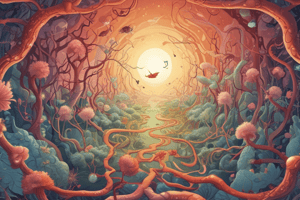Podcast
Questions and Answers
What is biology primarily concerned with?
What is biology primarily concerned with?
- The study of chemicals
- The environment
- The scientific study of life and living organisms (correct)
- The study of non-living things
What is the study of the structure and function of biomolecules?
What is the study of the structure and function of biomolecules?
- Ecology
- Zoology
- Genetics
- Molecular Biology (correct)
What is the process by which cells generate energy from glucose?
What is the process by which cells generate energy from glucose?
- Photosynthesis
- Cell Division
- Respiration (correct)
- Homeostasis
What is the jelly-like substance inside the cell membrane?
What is the jelly-like substance inside the cell membrane?
What is the study of the interactions between organisms and their environment?
What is the study of the interactions between organisms and their environment?
What is the process by which plants convert light energy into chemical energy?
What is the process by which plants convert light energy into chemical energy?
What is the study of heredity and variation?
What is the study of heredity and variation?
What is the semi-permeable membrane that surrounds the cell?
What is the semi-permeable membrane that surrounds the cell?
Study Notes
Definition and Scope
- Biology is the scientific study of life and living organisms
- It encompasses the structure, function, growth, evolution, distribution, and taxonomy of all living things
Branches of Biology
- Botany: study of plants
- Zoology: study of animals
- Microbiology: study of microorganisms
- Ecology: study of interactions between organisms and their environment
- Biochemistry: study of chemical processes that occur within living organisms
- Molecular Biology: study of the structure and function of biomolecules
- Genetics: study of heredity and variation
- Evolutionary Biology: study of the evolution of species
Biological Molecules
- Carbohydrates: provide energy and structure for cells
- Proteins: perform a wide range of functions, including catalysis, transport, and structure
- Lipids: provide energy and structure for cells
- Nucleic Acids: contain genetic information (DNA and RNA)
Cell Structure and Function
- Cell Membrane: semi-permeable membrane that surrounds the cell
- Cytoplasm: jelly-like substance inside the cell membrane
- Nucleus: contains genetic material
- Mitochondria: generate energy for the cell
- Ribosomes: site of protein synthesis
Biological Processes
- Photosynthesis: process by which plants convert light energy into chemical energy
- Respiration: process by which cells generate energy from glucose
- Cell Division: process by which cells reproduce and grow
- Homeostasis: ability of an organism to maintain a stable internal environment
Evolution and Diversity
- Species: group of organisms that can interbreed and produce fertile offspring
- Speciation: process by which new species arise
- Adaptation: process by which organisms become better suited to their environment
- Phylogeny: study of the evolutionary history of organisms
Definition and Scope
- Biology is the study of life and living organisms, including their structure, function, growth, evolution, distribution, and taxonomy.
Branches of Biology
- Botany studies plants, examining their structure, function, growth, and evolution.
- Zoology focuses on animals, exploring their behavior, physiology, and evolution.
- Microbiology delves into the world of microorganisms, such as bacteria, viruses, and fungi.
- Ecology investigates the interactions between organisms and their environment, including the impact of human activity.
- Biochemistry examines the chemical processes that occur within living organisms, including metabolism and energy production.
- Molecular Biology analyzes the structure and function of biomolecules, such as DNA, proteins, and carbohydrates.
- Genetics explores heredity and variation, including the inheritance of traits and genetic disorders.
- Evolutionary Biology studies the evolution of species, including the processes of adaptation and speciation.
Biological Molecules
- Carbohydrates provide energy and structure for cells, serving as a source of fuel and building blocks for biomolecules.
- Proteins perform a wide range of functions, including catalyzing metabolic reactions, transporting molecules, and maintaining cell structure.
- Lipids supply energy and structure for cells, forming cell membranes and storing energy.
- Nucleic Acids contain genetic information, with DNA and RNA serving as the blueprints for life.
Cell Structure and Function
- The cell membrane is a semi-permeable membrane that surrounds the cell, regulating the flow of materials in and out.
- Cytoplasm is the jelly-like substance inside the cell membrane, where many metabolic processes occur.
- The nucleus contains the genetic material, protecting and organizing the DNA.
- Mitochondria generate energy for the cell through cellular respiration, producing ATP.
- Ribosomes are the site of protein synthesis, where genetic information is translated into amino acid sequences.
Biological Processes
- Photosynthesis is the process by which plants convert light energy into chemical energy, producing glucose and oxygen.
- Respiration is the process by which cells generate energy from glucose, releasing ATP and carbon dioxide.
- Cell Division is the process by which cells reproduce and grow, involving the replication of DNA and the separation of chromosomes.
- Homeostasis is the ability of an organism to maintain a stable internal environment, despite changes in external conditions.
Evolution and Diversity
- A species is a group of organisms that can interbreed and produce fertile offspring, sharing a common gene pool.
- Speciation is the process by which new species arise, often through geographic isolation or genetic drift.
- Adaptation is the process by which organisms become better suited to their environment, increasing their chances of survival and reproduction.
- Phylogeny is the study of the evolutionary history of organisms, reconstructing their relationships and ancestral lineages.
Studying That Suits You
Use AI to generate personalized quizzes and flashcards to suit your learning preferences.
Description
Explore the definition and scope of biology, including its various branches such as botany, zoology, microbiology, ecology, and biochemistry.




